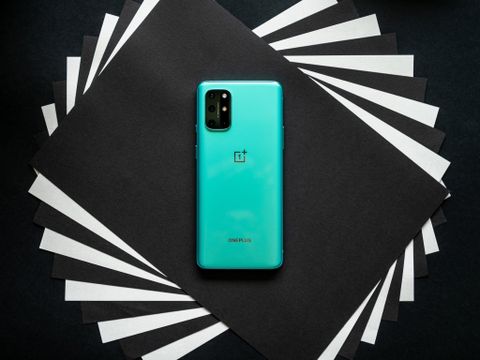Android Central Verdict
Bottom line: The OnePlus 8T has a sublime 120Hz display, and 65W fast charging eliminates any worries around battery use. With Android 11 out of the box, robust internal hardware, and a striking new design, the OnePlus 8T ticks all the right boxes.
Pros
- +
Gorgeous 120Hz AMOLED flat display
- +
65W fast charging is a game-changer
- +
One of the fastest Android phones
- +
Android 11 out of the box
- +
Decent cameras
Cons
- -
No IP rating
- -
No wireless charging
Why you can trust Android Central
OnePlus has to thread the needle every year with its mid-cycle T refresh. It needs to add enough new features that customers find a compelling enough reason to pick up the new phone, but not too many that it risks overshadowing its numbered flagship series.
OnePlus, therefore, has to strike the ideal balance when it comes to new features. With the OnePlus 8T, it has managed to do just that. The phone has internal hardware that's similar to the OnePlus 8 series, but it picks up 65W fast charging and a new design for the rear camera housing that makes it stand out. There's also a 120Hz display, and the screen itself is flat, unlike the OnePlus 8 series.
OnePlus is facing increased competition in this category with the introduction of the Samsung Galaxy S20 FE and the regular Galaxy S21, which at $800 is one of the best Android phones right now. The Pixel 5 also makes a strong claim with its outstanding camera and $699 price tag.
OnePlus isn't launching an 8T Pro, and the OnePlus 8 Pro — and OnePlus 9 Pro if you want the latest and greatest — continue to be the flagship options if you're looking to buy a OnePlus phone. So let's take a look at what the OnePlus 8T has to offer, and whether you should consider picking it up over the Pro models in OnePlus' portfolio.
OnePlus 8T Price and global availability
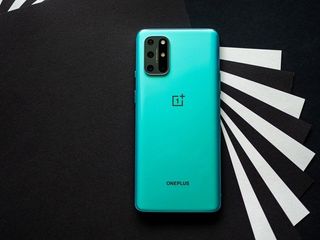
The OnePlus 8T launched on October 14, 2020, with availability kicking off starting October 23. The phone started off at $749, but with the introduction of the OnePlus 9 series, it has received a discount and is now available for $599. With the U.S. variant offering 12GB of RAM and 256GB of storage, you are getting a lot of value here.
In the UK, the OnePlus 8T debuted at £549 ($765), but is now available for £449 ($625) for the 8GB/128GB edition. Over in India, the 8T launched at ₹42,999 ($570) for the 8GB/128GB model, and is now available for ₹38,999 ($518) — ₹1,000 ($13) less than the OnePlus 9R, which is basically the same device.
OnePlus 8T Design
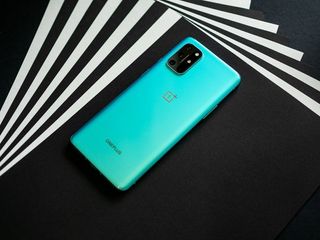
The OnePlus 8T doesn't deviate too much in terms of the design aesthetic from the OnePlus 8 series. You'll find the same rounded corners, same subtle curves at the back where the glass back meets the mid-frame, and the same metal chassis. You'll also find the hole-punch cutout for the front camera in the same location on the left, and the module itself is unobtrusive enough that you won't notice it.
OnePlus nailed the design aesthetic here, and the 8T is a great option if you don't like curved screens.
While the design language itself is largely unchanged, there are two key differences on the design front. There's a new camera housing at the back that makes the 8T look just that little bit more elegant, and the screen itself is flat — unlike the OnePlus 8 and 8 Pro. The OnePlus 8T is marginally wider, taller, and thicker than the OnePlus 8, and that's likely to do with the larger 4500mAh battery.
But the fact that the OnePlus 8T has a flat display makes a huge difference when it comes to usability. With no curved screen extending over to the mid-frame, you have a considerable portion of the phone to hold onto at the sides, and using the 8T next to the OnePlus 8 it's immediately evident just what sort of a difference this makes in daily usage. The in-hand feel is perfect, as is the weight distribution.
Let's talk about the other big design change: the rear camera housing. The housing is no longer centered at the back but sits to the left, and the module itself is wider than that on the OnePlus 8. The OnePlus 8T has four camera sensors and dual LED flash, and they're split into two columns: the three primary sensors are arrayed vertically and take up the first column, with the two LED flash modules and the fourth sensor in the second column.









OnePlus says one of the main reasons for moving the cameras to the side is to facilitate better cooling. The 8T has a larger vapor cooling chamber, and with the SoC positioned next to the camera housing, it shifted the cameras to the left.
I like the direction OnePlus is taking with the new design. The dual-column design makes the phone look more premium, and the clean layout is much better than the oblong module on the OnePlus 8 series. The best part is that the housing itself does not protrude a lot from the chassis, eliminating any wobble when using the phone on a flat surface.
Elsewhere, you'll find the alert slider on the right — above the power button — with the volume rocker on the left. The USB-C charging port sits at the bottom, with the primary speaker located to its left. To the right of the speaker is the dual SIM slot, and like recent OnePlus flagships you won't find a 3.5mm jack here.
OnePlus is sticking to Gorilla Glass 5 for the front and rear panes of glass, and I inadvertently managed to do a few drop tests as I used the device. My 8T landed on its bottom edge the first time it took a tumble, but the second time the screen took the brunt of the impact as the phone tumbled out of my hand onto tiled flooring. It thankfully emerged without any damage, and while the 8T is generally more comfortable to hold and use than a phone with a curved screen, you're better off picking up a case.
OnePlus is also introducing two new color options with the OnePlus 8T: Aquamarine Green and Lunar Silver. While the color technically features some green tones, it has a predominantly blue hue and is nearly identical to the Blue Marble finish on the OnePlus Nord.
OnePlus 8T Display

The big change on the display side of things with the OnePlus 8T is the 120Hz refresh rate, the same as the OnePlus 8 Pro and the 2021 OnePlus 9 series. The panel itself is unchanged from the OnePlus 8 series, delivering up to 1100nits of brightness in auto mode and HDR10+.
The OnePlus 8T has a 6.55-inch Fluid AMOLED display with an FHD+ resolution (2400 x 1080), and like recent OnePlus phones, there's an E3 layer that acts as a hardware-based blue light filter. The panel is one of the best you'll find in this category, and has excellent contrast levels, color vibrancy, and gets sufficiently bright in outdoor use.
Like the OnePlus 8 series, the OnePlus 8T has stereo sound, with the secondary speaker tucked away just above the display. The stereo speakers are great for playing games and streaming videos on the device.
The 120Hz AMOLED display on the OnePlus 8T is a delight to use — and AOD is a great new addition.
Switching to a 120Hz panel makes the OnePlus 8T that much more responsive in day-to-day use, and while you won't notice too much of a difference from a 90Hz screen, if you're coming from a regular 60Hz phone, you'll find plenty to love here. The high refresh rate makes everyday interactions like scrolling through social media or web browsing smoother, and you can immediately make out the difference from a 60Hz screen.
The other big change with the OnePlus 8T is that always-on display is finally available. This isn't limited to just the OnePlus 8T and is now available to all OnePlus devices running OxygenOS 11 update, but the OnePlus 8T gets the feature out of the box.
Considering OnePlus used AMOLED panels on its phones from the very beginning, it's astonishing it took the company this long to roll out AOD. But the feature is here now, and in typical OnePlus fashion you get a few extras. OxygenOS 11 has 11 AOD clock faces to choose from, and three distinct styles if you're looking for added customization.
The Insight AOD is the perfect tool for managing smartphone addiction.
My favorite is the Insight AOD style, which OnePlus designed in collaboration with New York's Parsons School of Design. The clock style features a vertical color bar representing your phone usage, and the bar diminishes the more you use your phone. You also get to see the date and time, number of times you've unlocked your phone, remaining battery, and unread notification icons.
The Insight style is designed to promote digital wellbeing, and the prominent color bar did a better job highlighting how much I use my phone than Google's Digital wellbeing controls that are tucked away in the settings.
There are two other AOD styles worth highlighting: Canvas automatically creates a wireframe outline of a photo you choose and lets you add it as the lock screen background. OnePlus is teaming up with Snapchat to roll out the Bitmoji AOD, giving you the option to use your own personal Bitmoji avatar on the lock screen. Your Bitmoji avatar will change dynamically throughout the day based on your activity. The Canvas and Bitmoji AOD styles debuted shortly after the release of the phone, and they are a nice addition if you're looking for added customization.
OnePlus 8T Hardware

OnePlus isn't making too many changes to the hardware with the OnePlus 8T. The phone is powered by the Snapdragon 865 — just like the OnePlus 8 and 8 Pro — and it has LPDDR4X RAM and UFS 3.1 storage module.
OnePlus usually tends to use Qualcomm's latest available silicon on its flagships, but this time, we're not getting the Snapdragon 865+. OnePlus says the Snapdragon 865 continues to deliver class-leading performance for gaming and all day-to-day tasks, and with the 865+ offering marginal gains, it didn't see the value in switching to a new chipset.
| Specs | OnePlus 8T |
|---|---|
| Software | Android 11, OxygenOS 11 |
| Display | 6.55-inch 120Hz AMOLED |
| Chipset | 2.84GHz Snapdragon 865 |
| RAM | 8GB/12GB |
| Storage | 128GB/256GB |
| Rear Camera 1 | 48MP ƒ/1.7 (primary) |
| Rear Camera 2 | 16MP ƒ/2.2 (wide-angle) |
| Rear Camera 3 | 5MP (macro) |
| Rear Camera 4 | 2MP (monochrome) |
| Front Camera | 16MP ƒ/2.4 |
| Connectivity | Wi-Fi 6, BT 5.1, NFC |
| Battery | 4500mAh, 65W Warp Charge 65 |
| Security | In-screen fingerprint |
| Colors | Aquamarine Green, Lunar Silver |
| Dimensions | 160.7 x 74.1 x 8.4mm |
| Weight | 188g |
While I like using the latest hardware, OnePlus' decision to go with the Snapdragon 865 is a smart one. Using the Snapdragon 865+ would have meant that OnePlus had to optimize the software for the chipset from scratch.
With the Snapdragon 865 already optimized for OxygenOS and delivering a similar level of performance, OnePlus can offer a bug-free experience from day one by leveraging the existing chipset. OnePlus launches in the last 18 months have been plagued by persistent software issues that weren't fixed until a few weeks after the launch, and that's thankfully not the case on the OnePlus 8T — the phone is stable to use and bug-free out of the box.
The OnePlus 8T is available with either 8GB of RAM and 128GB of storage, or 12GB of RAM and 256GB of storage. OnePlus is using UFS 3.1 storage modules for the first time, but in day-to-day use, you won't notice any difference between the UFS 3.0-based OnePlus 8 series. OnePlus is selling just the 12GB/256GB model in the U.S. for $749, but in other markets, customers will be able to choose between the 8GB and 12GB variants.
Interestingly, the OnePlus 8T has LPDDR4X DRAM modules, and when I asked OnePlus why it didn't use the latest LPDDR5 standard, I was told that the LPDDR4X modules deliver the same level of performance. With no tangible difference in performance and LPDDR4X modules much more affordable, OnePlus went with the older modules instead.
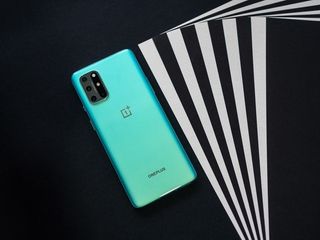
When it comes to real-world performance, the OnePlus 8T is one of the fastest Android phones money can buy today. I didn't notice any lag or slowdown during day-to-day tasks like browsing social media or reading long-form content on the phone, and the 8T is one of the best phones for playing games.
The Snapdragon 865 chipset coupled with the Adreno 650 GPU allow the OnePlus 8T to deliver outstanding performance in demanding games as well, and the phone itself doesn't overheat during extended gaming sessions. OnePlus is using a large vapor cooling chamber on the 8T, and it does a great job with heat dissipation.
The OnePlus 8T delivers superlative performance — you won't see any slowdowns here.
The Snapdragon 865 has an external X55 5G modem, and while the modem offers both Sub-6 and mmWave 5G connectivity, OnePlus is using just Sub-6 bands on the 8T. Adding mmWave connectivity increases the cost by around $100 — as we've seen for the Pixel 5, and with most carriers using Sub-6 for their 5G rollout, OnePlus is limiting the 8T to the low-band frequency.
Elsewhere, the OnePlus 8T has Wi-Fi 6, Bluetooth 5.1, NFC, and AptX HD, LDAC, and AAC audio codecs. I had zero issues with Wi-Fi connectivity on the device, and I regularly got over 300Mbit on my home network. I didn't see any issues with making or receiving calls either, and you can use Wi-Fi calling — provided your carrier offers it, of course.
While the phone itself is water resistant, OnePlus isn't paying to get it certified for an IP rating. The only 8T model that offers an IP68 rating is the T-Mobile version, with the unlocked variant and global models missing out. OnePlus has confirmed that there's no difference between the T-Mobile version and the unlocked variants, just that it isn't paying for the IP rating. Oh, and the 8T isn't available on Verizon, with carrier availability limited to T-Mobile. Make of that what you will.
The optical in-display fingerprint reader is just as fast and reliable as on the OnePlus 8 series, and I did not face any issues in this particular area. The OnePlus 8T features the same excellent haptic engine as the OnePlus 8 Pro, and it is wonderfully detailed. The motor delivers fine-tuned feedback and is generally a delight to use, particularly with gesture navigation. Android phone manufacturers have come a long way in this area over the last 18 months, and it's good to see OnePlus not make any compromises here.
Overall, the OnePlus 8T has everything you're looking for on the hardware front. The Snapdragon 865 is an excellent performer, and the chipset will hold its own for several years. OxygenOS is optimized to take advantage of the 120Hz screen, and while there's no shortage of phones powered by the Snapdragon 865, OnePlus phones tend to feel just that little bit more refined in day-to-day use. That's the case on the OnePlus 8T as well, and the phone is a standout option if you care about day-to-day performance.
OnePlus 8T Battery life
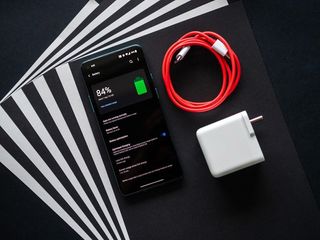
The marquee feature on the OnePlus 8T is Warp Charge 65. The 65W fast charging standard delivers a full charge in just 39 minutes, altering how you use your phone. OnePlus is touting up to a 50% charge in just 15 minutes, giving you enough power to last several hours.
To facilitate Warp Charge 65, OnePlus made a few changes to the battery on the 8T. Instead of a single 4500mAh battery, the phone has two 2250mAh batteries that receive a 32.5W charge simultaneously. That's what allows for the huge gains in charging speeds, and as most of the charging circuity is housed within the wall charger, the device itself doesn't overheat when charging.
Warp Charge 65 fundamentally changes how you use your phone.
The 65W charge is delivered over 10V at 6.5A, and is split evenly between the two batteries on the phone. OnePlus says the 8T has 12 sensors to conduct charge effectively and ensure the phone doesn't overheat, and I didn't find any issues in this particular area.
OnePlus' figures hold up in real-world testing, and it does take just 39 minutes to fully charge the 4500mAh battery on the OnePlus 8T. I got a day's worth of usage consistently with AOD enabled, and although the battery life went down to 10% on one day with just four hours of SOT, that was because of an issue with a particular OxygenOS feature called Work-Life Balance. Otherwise, I consistently got over five hours of SOT spread out over the course of 15 hours with a 15% charge left over.
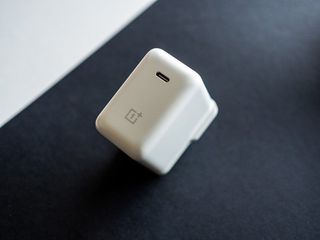
The Warp Charge 65 charging tech itself is licensed from OPPO, which also uses a dual-cell charging system on the Find X2 series, but OnePlus is adding a few extra features that are noteworthy. Key among them is the fact that the Warp Charge 65 wall charger also works with the USB PD protocol at up to 45W — a first for the brand.
The Warp Charge 65 charger hits 45W in USB PD mode, giving you the ability to charge other phones.
Earlier Warp Charge wall units were limited to OnePlus phones, falling back to 10W charging for any other device. But with the Warp Charge 65 wall plug, you can charge any other PD-compatible device — including your notebook — at up to 45W. OnePlus has switched to a USB-C connector on the wall plug to accommodate the PD spec, and the ability to charge other devices makes the charger that much more versatile.
Yes, OnePlus will sell the Warp Charge 65 charger as a standalone accessory on its website, so if you are looking for a USB PD charger that goes up to 45W, it is a decent option. OnePlus says the Warp Charge 65 charger will be able to charge older OnePlus devices at up to 27W, and it works as advertised on the OnePlus 8 and 8 Pro.
The one downside in this area is that there's no wireless charging on the OnePlus 8T, but that honestly doesn't matter much in day-to-day use. With 65W wired charging, you don't actually need to worry about charging times.
OnePlus 8T Cameras
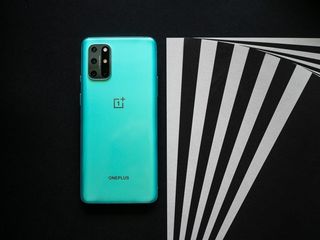
OnePlus doesn't tend to make too many changes on the camera front with its mid-cycle T refresh, and that's the case with the OnePlus 8T as well. The 8T retains the same 48MP Sony IMX586 primary sensor as the OnePlus 8, and if you need the newer IMX689 sensor, you'll have to pick up the OnePlus 8 Pro.
That said, the OnePlus 8T gets new auxiliary modules: there's a 16MP wide-angle sensor that leverages the Sony IMX481, with OnePlus touting that it offers a 123-degree field of view. You also get a 5MP macro lens, and a 2MP monochrome lens.
The OnePlus 8T has decent cameras, but it is plagued by the same issues as the OnePlus 8.
Finding the monochrome mode in itself is a hassle: you'll have to select the filters in the camera app, browse all the way to the end, and choose Mono. The monochrome sensor is there to add extra information, and when you select the Mono filter, it'll just overlay a black-and-white effect while the primary 48MP sensor takes the image.
The camera interface itself hasn't changed, and if you've used a OnePlus phone in the past, you will be immediately familiar with the layout of the shooting modes and various options. The modes are laid out in a ribbon at the bottom, and Google Lens integration is baked into the camera. You can choose between the default 12MP mode or go with the full-res 48MP option, choose from various filters, and adjust settings for the flash, timer, and access macro mode easily from the viewfinder.
You can switch between the wide-angle lens, primary lens, and a digital 2x zoom lens via the viewfinder, and the dedicated night mode works with the wide-angle lens out of the box. OnePlus is touting video-related enhancements thanks to a new video stabilization algorithm, but the big deal here is that the OnePlus 8T lacks 8K video recording.
With Samsung, Xiaomi, and others positioning 8K video as the differentiator, it's weird to see OnePlus miss out on the feature. For what it's worth, the OnePlus 9 and 9 Pro offer the feature, so if you've been itching to try out 8K video, you should pick up OnePlus' 2021 flagships.








As for the camera quality on the 8T, it's decidedly average. The fact that OnePlus is still using the IMX586 limits the quality of the resultant shots, and while the phone takes decent enough shots in most lighting conditions, it is on the backfoot against the likes of the Pixel 5, Galaxy S20 FE, and the Mi 10.
Daylight shots taken with the OnePlus 8T have plenty of detail and good dynamic range, and the wide-angle lens does a better job retaining the same color profile as the primary sensor. That said, the camera doesn't quite measure up in low-light scenarios; there's too much noise, and shots tend to be either under or overexposed. Colors also look washed out, and while the resultant images are good enough for sharing on social media platforms, you'd want better cameras when paying this much for a phone.
That said, OnePlus rolled out a software update a few weeks after the 8T went on sale to fix the issues with low-light photos, and the phone holds up much better than my initial testing.
OnePlus 8T Software
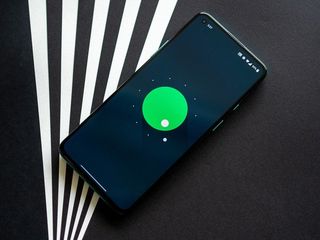
OnePlus made a lot of positive strides in the software front over the last two years, and it is embarking on a new journey with OxygenOS 11. The skin is based on Android 11 and has a bold new visual style that's very different to previous versions.
The new visual layout is designed to facilitate one-handed use, with most interface elements sitting further down on the page. The UX is very similar to Samsung's One UI 3.0, but for what it's worth, it works well on devices like the 8T.
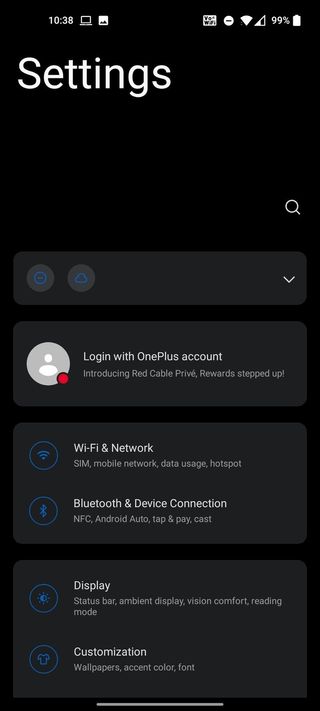

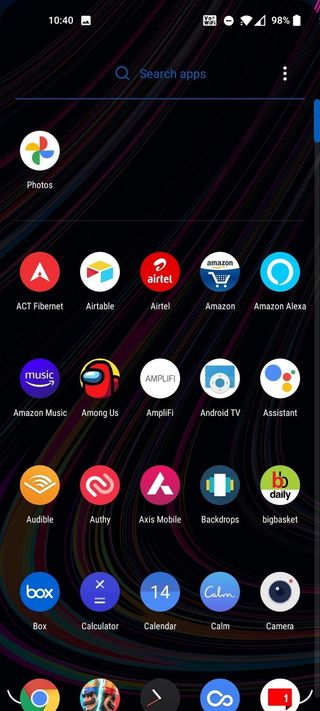
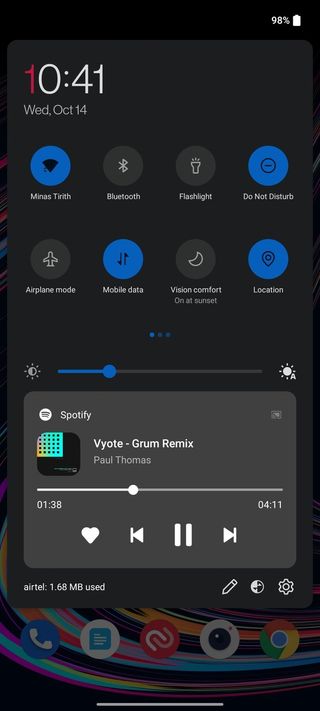

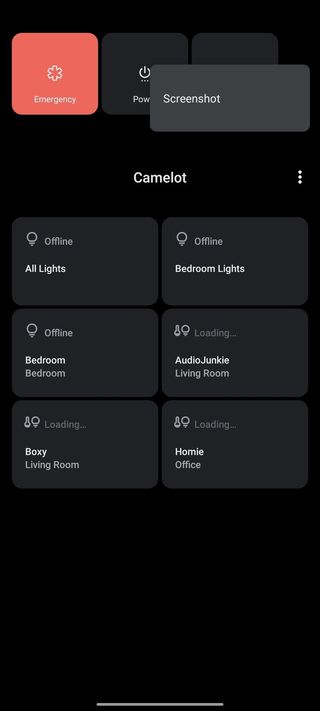
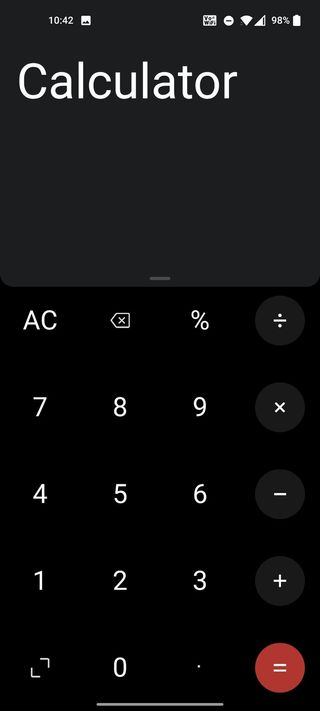


Source: Android Central
OnePlus attracted a lot of enthusiast users over the last six years, and one of the main reasons was because of the clean software that blended into the background. With OxygenOS 11, OnePlus is putting some of its identity into the software as well as it tries to differentiate itself in this area. With OnePlus now focused on the mainstream segment, the changes in OxygenOS 11 have been targeted at making sure regular users find the UI familiar.
OxygenOS 11 is a big visual change, but it does include a lot of exciting new features.
I used OxygenOS 11 for several months now, starting off with the beta builds on the OnePlus 8 Pro and switching to the stable build on the OnePlus 8T. I'll admit that I don't mind the changes as much now as I did when I first saw them, and OnePlus' reasoning for overhauling the UI makes sense considering the positioning of the 8T.
While the UI itself looks different, OnePlus hasn't messed with the customization options, and that means OxygenOS still has a lot to offer in this area. You can change the accent colors, clock styles for AOD, animations for the in-screen reader, system icons, and even the font. Google's default navigation system is available here, and you get to switch to gesture navigation while setting up the phone — a nice touch.
Talking about Google, OnePlus is ditching its own dialer and messages app in favor of Google's communication suite. The OnePlus 8T comes with Google's dialer and Messages out of the box, but OnePlus' Gallery app is intact. OnePlus took a similar strategy with the Nord, and it's clear that this is the way going forward. If you liked using OnePlus' Messages app, you can now find it on the Play Store.
OxygenOS 11 is the update that OnePlus needed to challenge Samsung going forward.
I covered all the new features in OxygenOS 11 extensively, but I'll do a brief rundown. As the skin is built on top of Android 11, it gets all the new features Google introduced in the latest version of Android. That means a Conversation view that puts all conversations at the top of your notifications, chat bubbles, and a persistent media player in the pull-down notification pane.
OnePlus-exclusive changes include dynamic backgrounds, the ability to schedule dark mode, AOD, a new OnePlus Sans font that has better readability, and big changes to Zen Mode. The mode has three new themes and is collaborative — you get the option to invite your friends to take part in Zen Mode.
OnePlus is debuting a straighten doc feature that uses OCR to fix alignment of documents. There's also a voice dictation mode that will be baked into OnePlus Notes, but that hasn't showed up just yet.
While OxygenOS 11 has a lot of visual changes, it is optimized just as well and runs just as fluid as earlier versions of the skin. I didn't notice any software-related issues in my usage, and it still retains its customizability. OxygenOS 11 is a big change for OnePlus, and it is a divisive one for its vocal community. There will always be users that won't like the design changes here, but the move sets up the company to better position itself as a challenger to Samsung in the mainstream segment.
OnePlus 8T The competition

There's a lot of choice if you're looking to pick up a phone in the vicinity of $700. The Samsung Galaxy S20 FE is the obvious contender to the OnePlus 8T as it offers similar hardware and value. The S20 FE is also powered by the Snapdragon 865 chipset, has a 120Hz AMOLED panel, the same primary camera as the S20, and a 4500mAh battery with 25W wired and 15W wireless charging. The S20 FE is available for $649, making it a standout option.
The OnePlus 8 Pro itself is a great option to consider in 2021. The phone is now retailing for just $699 — or $100 more than the 8T. The 8 Pro is packing a high-res QHD+ AMOLED display that goes up to 120Hz, you get better cameras, IP68 rating as standard, and 30W wireless charging. The 8 Pro is not as comfortable to hold and use as the 8T, but you can't argue the fact that it gives you much more in the way of features.
Then there's the Pixel 5. Google's 2020 flagship is powered by the Snapdragon 765G, but it comes with Sub-6 and mmWave 5G connectivity, a 90Hz OLED panel, a sublime primary camera at the back that's joined by a wide-angle lens, 15W wireless charging, and three years of guaranteed Android version updates. The camera alone makes the Pixel 5 a stellar option for $699 in 2021.
The Xiaomi Mi 10 is also a viable alternative to the OnePlus 8T in India. The device is powered by the Snapdragon 865 chipset, has 30W wired and wireless charging, an outstanding 108MP camera, and a 90Hz AMOLED panel. Now retailing at ₹44,999 ($615) on Amazon India, the Mi 10 has a lot to offer.
OnePlus 8T Should you buy?

You should buy this if ...
You need stellar hardware
With a Snapdragon 865 chipset, 120Hz AMOLED display, UFS 3.1 storage and LPDDR4X RAM modules, the OnePlus 8T is one of the fastest phones money can buy today.
You want a great software experience
The OnePlus 8T comes with Android 11 out of the box, and there's plenty of customizability. OxygenOS 11 looks different to previous versions of the UI, but it doesn't have any bloat and gets timely updates.
You're looking for ultra-fast charging
Thanks to Warp Charge 65 and an innovative dual-battery system, the OnePlus 8T needs just 39 minutes to fully charge the 4500mAh battery.
You should not buy this if ...
You're in the market for a great camera
The OnePlus 8T retains the same optics as the OnePlus 8, and although the 48MP camera is tuned well out of the box, there's the fact that it does not measure up to the Galaxy S20 FE, Pixel 5, or the Mi 10 in this segment.
You want wireless charging
While the OnePlus 8T has 65W wired charging, there is no wireless charging here.
You want a phone with an IP rating
OnePlus says the 8T is "pretty much waterproof," but the IP68 rating is limited to U.S. carrier models, with the unlocked and global variants missing out.
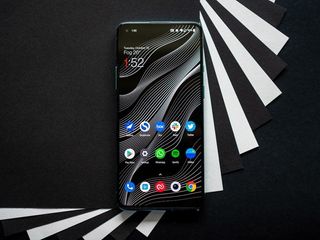
Ultimately, the OnePlus 8T gets a lot right. The design is a step forward for OnePlus, and the flat display makes it a delight to use the phone. The phone has the latest internal hardware, clean software without any bloatware, and 65W fast charging is a major differentiator.
If you held off on buying the OnePlus 8 series because of usability issues with the dual-curved panels or are looking to upgrade from the OnePlus 6 series, you'll find plenty to like in the OnePlus 8T.
4 out of 5
That said, the OnePlus 8T doesn't quite hold its own in the camera category. The Galaxy S20 FE, Pixel 5, and even the Mi 10 offer a better camera in this segment, and while OnePlus did a better job tuning the camera here, you don't get the same caliber of photos.
So if you're more interested in the real-world performance and don't mind the fact that the cameras aren't on par with the best that this segment has to offer, the OnePlus 8T is an easy recommendation. That's particularly true in India, where the device is selling for just ₹38,999 ($518), making it an incredible bargain.
OnePlus 8T Changelog, April 2021

This review was initially published on October 14 after a week's worth of use, and has been updated on April 21, 2021 with long-term usage notes and the following changes:
- Added an availability section detailing what the 8T costs in global markets.
- Added more devices to the competition section.
- Included long-term testing notes following the launch of the OnePlus 9 series.
OnePlus 8T 6-month later review
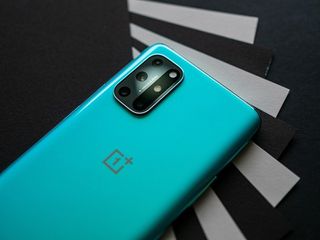
Six months after its launch, the OnePlus 8T continues to be one of the fastest phones in the market. The phone hasn't slowed down at all in the intervening months, and it is just as delightful to interact with the 120Hz AMOLED panel and play games or stream movies on the device. There's plenty of power here to last several years.
The biggest differentiator for the 8T is 65W charging. I don't even notice the fact that the phone lacks wireless charging, and I also like the USB PD charger that's bundled with the phone — it is a versatile option and can be used for charging other phones or accessories.
OnePlus rolled out a few updates to fix the camera processing on the 8T, and the result is that the device takes better photos now. It's still not on the same level as what Google and Samsung offer in this category, but it is a far sight better than what we got at launch.
On the software side of things, the 8T continues to get regular updates, including monthly security patches. OxygenOS 11 is a known quantity at this point, and having used the 8T extensively over the last six months, I have no issues with the software.
It's interesting to see where the OnePlus 8T slots into the company's portfolio in 2021. With the OnePlus 9 retailing for $729, the 8T is the obvious choice now that it's on sale for $599. Of course, you can also pay $100 more and get your hands on the OnePlus 9 Pro.
OnePlus introduced the OnePlus 9R as a more budget-focused alternative to the OnePlus 9 and 9 Pro, and the device is essentially the 8T with a slightly new design. The phone is limited to India and China, and at ₹38,999 it costs more than the 8T. You're not really getting anything on the 9R that's not already available on the 8T, and the downside is that the phone lacks the USB PD charger that you get with the 8T. So if you're looking to buy a OnePlus phone for under ₹40,000 in India in 2021, the 8T continues to be my recommendation.

Harish Jonnalagadda is a Senior Editor overseeing Asia at Android Central. He leads the site's coverage of Chinese phone brands, contributing to reviews, features, and buying guides. He also writes about storage servers, audio products, and the semiconductor industry. Contact him on Twitter at @chunkynerd.
